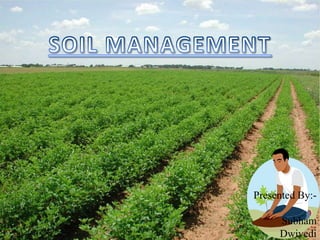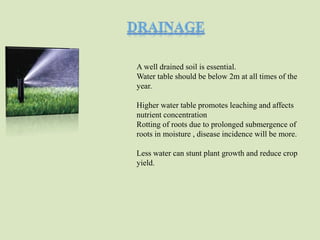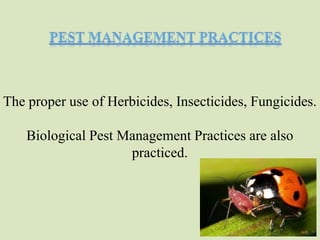Soil management
- 2. • Acts as the key resource in crop production • It supports the physical, chemical, and biological processes • Regulates water flow such as Infiltration Root-zone storage Deep percolation Run-off
- 3. Soils can classified on the basis of particle size Inorganic soils Less than 10% of organic matter in the surface layer Amounts of sand silt and clay constitute the inorganic portion. Sandy Soils Coarse Textured and have large pore spaces Poor water holding capacity Low nutrient retaining ability Loamy Soils Significant amount of sand, silt and clay Described as sandy loam or silty loam or clay loam depending upon the predominating component of the soil
- 4. Clay Soil Fine textured and have small pore-spaces. Not suitable for raising most of the horticulture crops. Mangoes can be practically grown in rich clayey soil, it produces more of vegetative growth with little fruit production Organic Matter Formed by Decomposed plant and animal tissue & micro organism Forms dark non crystalline colloidal substance called humus. Organic matter are reservoirs of plant nutrients Green Manure Crops-A rapid method of increasing the organic matter content in the soil.
- 5. The capacity of soil to nourish and sustain plant growth Fertility is maximum in the top layer (15-60 cm) & declines as it goes deeper and deeper Factors responsible for depletion of soil fertility • Erosion • Leaching ; and ; • Volatization The soil depth should be 1-2m for most of the fruit crops for normal growth and development. Shallow soils with hard and com pact subsoil layers like rocks and heavy clay should be avoided for fruit crops as in such soils that root grows in the top layer of soil parallel to the surface . Such trees are easily uprooted by winds or premature death of trees may also occur.
- 6. A pH of neutral and below 7 and acidic and above are alkaline Soil reaction influences nutrient availability. Influences the activity of soil bacteria which in term affects the plant nutrients Soil can be made :- Less alkaline by applying acid producing chemical E.g. Aluminium sulphate , sulphur and gypsum. Less acidic by applying hydrated lime or lime stone Area of heavy rainfall leaching removes many soluble carbonates resulting in more acidic soils
- 7. A well drained soil is essential. Water table should be below 2m at all times of the year. Higher water table promotes leaching and affects nutrient concentration Rotting of roots due to prolonged submergence of roots in moisture , disease incidence will be more. Less water can stunt plant growth and reduce crop yield.
- 8. 2000 million microbes in a tablespoon of soil The main groups of soil microbes are Algae minute chlorophyll plants Fungi without chlorophyll Bacteria unicellular organisms 1.Cause organic matter to heat, decay and release the nitrogen continued in them as ammonia. 2.Convert ammonia into nitrous acid and nitrites by uniting it with the basic elements in the soil. 3. Convert nitrites to nitrates in which form the plant gets their nitrates from the soil through their roots in a state of solution. 4.Some live in the nodules of leguminous plants and those nitrogen directly from the air and fix it in those nodules to be built into nitrogen compounds useful to themselves and to plant by other set of organisms
- 9. The proper use of Herbicides, Insecticides, Fungicides. Biological Pest Management Practices are also practiced.
- 10. Healthy Soil = Healthy Plants !
- 11. Thanks For Your Attention !











